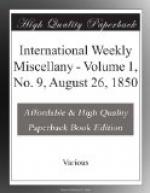In this formidable movement the highlander’s natural freedom is fanned into a blaze by a religious zeal like that which once led the armies of Islam over one half of Asia and Europe. Although it reached its highest energy and a more consummate development under Schamyl, it was begun by his predecessors. Of the Mullah Mohammed, who first preached the duty of casting off the yoke of the Giaour, and the necessity of a religious reform and union of rival sects, as a means to that end, we have already spoken. This founder of the new system, an aged man, untrained in arms, never himself drew the sword in the cause; but was active in diffusing its principles and preparing a warlike rising by exhortations and letters circulated through all Daghestan. Suspected of these designs, he was seized, in 1826, by the orders of Jermoloff; and although be escaped,—by the connivance, it is said, of the native prince employed to capture him,—he afterward lived, in a kind of concealment, for some years. The post of Imam was thereupon assumed by a priest who was able to fight for the new doctrine as well as to preach it. The first armed outbreak took place under Kasi-Mullah, about the year 1829; from which time, until his death in a battle at Himry, in 1831, he waged a terrible, and, although often defeated, a virtually successful warfare, against the Russians, while he prosecuted the work of conversion among the tribes of Islam who delayed to acknowledge his mission, and to join in his enmity to the Russians, by the extremities of bloodshed and rapine. His death, after an heroic resistance, was hailed as a triumph by the Russians. They counted on the extinction of the new sect in the defeat of its leader, whose dead body they carried about




